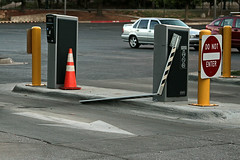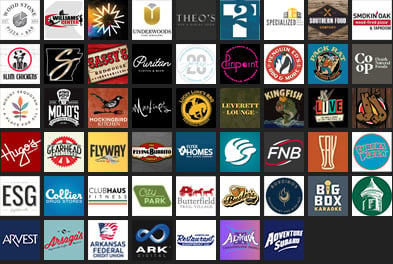
City officials presented their annual report of the Dickson Street area paid parking program to members of the Fayetteville City Council on Tuesday.
The 14-month-old plan, which includes a system of kiosks, gated lots, on-street numbered parking spaces and residential parking boundaries, is responsible for a vastly different atmosphere in a roughly two-square-mile area around Dickson Street.
Now that we’ve had a full year to evaluate things, it appears as though the change hasn’t been nearly the business killer some predicted it to be.
Some businesses are gone (WOW Japanese Bistro, El Sancho, Sunrise Cafe) and some have relocated (Geno’s, Kosmos), but some have moved in (Farrell’s, Pitas, Rowdy Beaver, Chipotle, Waffle House) and some have even expanded their business (Feltner’s, Grub’s).
At the one-year mark, HMR tax numbers were up 6.1 percent in the Dickson Street area. Citywide, 2011 collections are currently up 4.82 percent on the year.
With the primary goal of the program being to finance a parking deck, and with design and bond discussions already underway, all we’re missing now are parking-specific statistics.
Here’s what we found out on Tuesday:
Since implementation, numerous changes have been made to the system including:
- The daily start time for paid parking was changed from 10 a.m. to 2 p.m.
- The maximum daily rate was reduced from $8 to $5
- The grace period for entering and exiting the gated lots for free was increased to 30 minutes
- A 90 percent discount for area employees was added
- A pay-by-phone service was added
- The number of permits allowed per household in residential areas was increased from 2 to 4
- 4 blocks of mixed use areas were added for residential parking
- Designated areas for trash bins were added in residential areas
- An event parking model was implemented in the main WAC lot during large shows at the Walton Arts Center
The changes, however, were anticipated, and according to city staff, were directly responsible for low revenue projections.
According to Tuesday’s report, parking fees and revenue from citations (less sales tax) totaled $943,024. That’s nearly $40,000 more than was budgeted for the year.
With monthly payments already included in the budget, the city’s equipment purchase (about $810,000 worth) is on track to be paid back on schedule, in five years.
Also on target to be paid in full is the annual $289,000 Walton Arts Center is to receive for parking attendants and arts programming, a secondary goal of the paid parking plan.
A look at the stats alone would suggest paid parking has gone off without a hitch. That, of course, is not the case.
Kiosks have been spray painted, gate pins continue to be snapped in half at lot exits, and less than two months ago, six-foot-tall fences were installed around the gated lots to keep drivers from jumping the curbs to avoid paying.
Sharon Waters, parking and telecommunications manager for the city, chalks most of the damage up to the nature of the Dickson Street area.
“You’re going to have vandalism in a bar district no matter what your program is,” said Waters.
With area business life, revenue numbers, the original goals of the plan, and even continued vandalism all accounted for, it looks like paid parking is here to stay.
Arguments, as far as the city is concerned, will likely have little impact outside of minor changes to the system.
Of course, by the time the equipment is paid for in a few years, it will be difficult to find a group of university students who can even recall life on Dickson Street before numbered spaces.
Will the rest of Fayetteville eventually surrender to the talking kiosks and gated arms of paid parking?
We’ll let you know.




